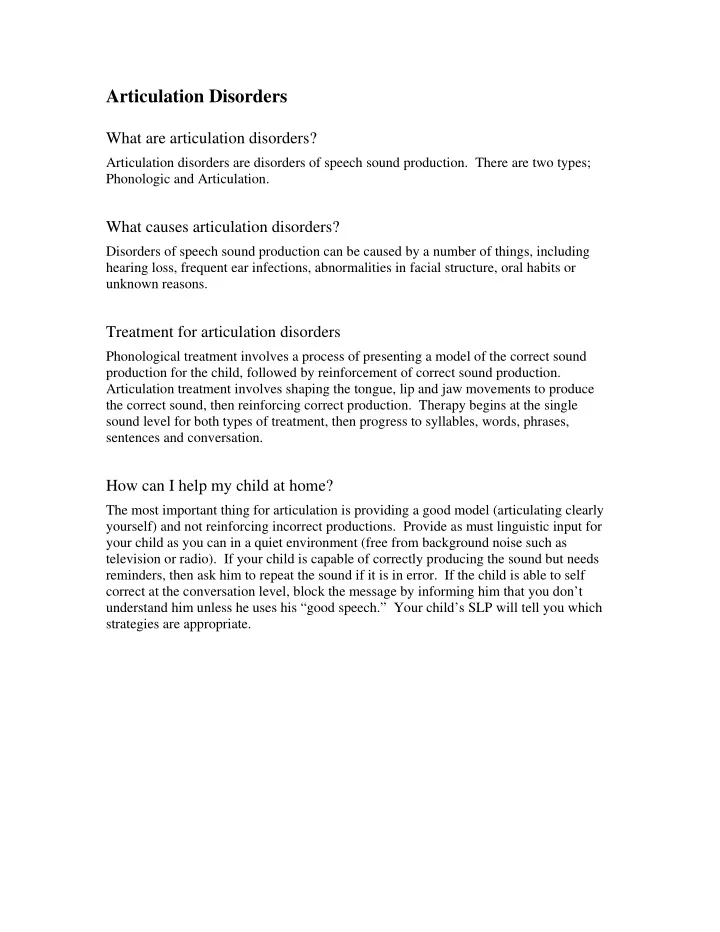

Articulation Disorders What are articulation disorders? Articulation disorders are disorders of speech sound production. There are two types; Phonologic and Articulation. What causes articulation disorders? Disorders of speech sound production can be caused by a number of things, including hearing loss, frequent ear infections, abnormalities in facial structure, oral habits or unknown reasons. Treatment for articulation disorders Phonological treatment involves a process of presenting a model of the correct sound production for the child, followed by reinforcement of correct sound production. Articulation treatment involves shaping the tongue, lip and jaw movements to produce the correct sound, then reinforcing correct production. Therapy begins at the single sound level for both types of treatment, then progress to syllables, words, phrases, sentences and conversation. How can I help my child at home? The most important thing for articulation is providing a good model (articulating clearly yourself) and not reinforcing incorrect productions. Provide as must linguistic input for your child as you can in a quiet environment (free from background noise such as television or radio). If your child is capable of correctly producing the sound but needs reminders, then ask him to repeat the sound if it is in error. If the child is able to self correct at the conversation level, block the message by informing him that you don’t understand him unless he uses his “good speech.” Your child’s SLP will tell you which strategies are appropriate.
Stuttering Why do people stutter? The exact cause of stuttering is unknown, but it is believed to be caused by a combination of a genetic predisposition, a language disorder and a perfectionist temperament. What is stuttering? Stuttering is a dysfluency of speech, either in the form of excessive use of fillers (i.e. “um”), whole word repetitions, single sound repetitions or “blocks” during which the person is unable to speak at all. How can stuttering be treated? The treatment for stuttering is primarily behavioral. The SLP will evaluate the speech patterns of the person who stutters, and determine specific techniques which improve fluency. Typically these techniques consist of slowing speaking rate and relaxation at the point of stuttering blocks. Social emotional treatment can also be helpful, to alleviate the stress of stuttering. What can I do to help the person who stutters? A stuttering event is uncomfortable for both the speaker and the listener. The most important thing for the listener to remember is not to create any additional pressure on the speaker to communicate. Give the speaker plenty of time and maintain eye contact. Statements such as “relax” and “take it easy” increase the pressure on the speaker and could make the stuttering event worse. You can also directly ask the person who stutters what type of response helps them to communicate.
Voice Disorders What are voice disorders? Voice disorders are a change in volume, quality of pitch of the voice due to damage in the Larynx. Hypo functional voice disorders result in a low volume, hoarseness and reduced vocal pitch. Hyper functional voice disorders result in inconsistent vocal quality and pitch. What causes voice disorders? Voice disorders can be cause by post-nasal drip, allergies, growths (both benign and cancerous) on the vocal cords or nerve damage. Before beginning any treatment for voice disorders a physician must examine the vocal cords to determine the exact cause of the problem. A cancerous growth must be ruled out, and the nature of the problem must be determined before the therapist can begin treatment. Treatment for voice disorders The treatment for voice disorders is based on the cause of the problem, but may consist of relaxation techniques, vocal rest, vocal hygiene, or exercises designed to force the vocal folds together.
Recommend
More recommend